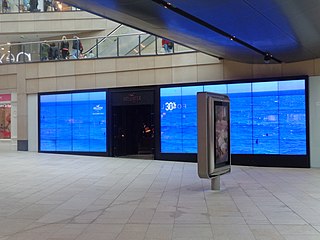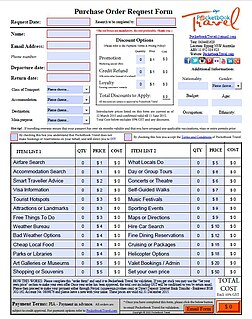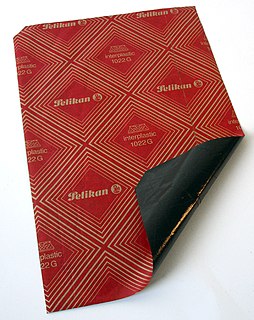Related Research Articles

Sales are activities related to selling or the number of goods sold in a given targeted time period. The delivery of a service for a cost is also considered a sale.

The Uniform Commercial Code (UCC), first published in 1952, is one of a number of Uniform Acts that have been established as law with the goal of harmonizing the laws of sales and other commercial transactions across the United States through UCC adoption by all 50 states, the District of Columbia, and the Territories of the United States.

The point of sale (POS) or point of purchase (POP) is the time and place where a retail transaction is completed. At the point of sale, the merchant calculates the amount owed by the customer, indicates that amount, may prepare an invoice for the customer, and indicates the options for the customer to make payment. It is also the point at which a customer makes a payment to the merchant in exchange for goods or after provision of a service. After receiving payment, the merchant may issue a receipt for the transaction, which is usually printed but can also be dispensed with or sent electronically.
Caveat emptor is Latin for "Let the buyer beware". It has become a proverb in English. Generally, caveat emptor is the contract law principle that controls the sale of real property after the date of closing, but may also apply to sales of other goods. The phrase caveat emptor and its use as a disclaimer of warranties arise from the fact that buyers typically have less information than the seller about the good or service they are purchasing. This quality of the situation is known as 'information asymmetry'. Defects in the good or service may be hidden from the buyer, and only known to the seller.

In the United States, a car dealer is a business that sells cars. A car dealership can either be a franchised dealership, which is a retailer that sells new and used cars, or a used car dealership which only sells used cars. In most cases franchised dealerships include certified pre-owned vehicles, employ trained automotive technicians, and offer financing. In the United States, direct manufacturer auto sales are prohibited in almost every state by franchise laws requiring that new cars be sold only by dealers.
A hire purchase (HP), also known as an installment plan or the never-never, is an arrangement whereby a customer agrees to a contract to acquire an asset by paying an initial installment and repays the balance of the price of the asset plus interest over a period of time. Other analogous practices are described as closed-end leasing or rent to own.

A purchase order (PO) is a commercial document and first official offer issued by a buyer to a seller indicating types, quantities, and agreed prices for products or services. It is used to control the purchasing of products and services from external suppliers. Purchase orders can be an essential part of enterprise resource planning system orders.
An invoice, bill or tab is a commercial document issued by a seller to a buyer, relating to a sale transaction and indicating the products, quantities, and agreed prices for products or services the seller had provided the buyer.

A letter of credit (LC), also known as a documentary credit or bankers commercial credit, or letter of undertaking (LoU), is a payment mechanism used in international trade to provide an economic guarantee from a creditworthy bank to an exporter of goods. Letters of credit are used extensively in the financing of international trade, where the reliability of contracting parties cannot be readily and easily determined. Its economic effect is to introduce a bank as an underwriter, where it assumes the counterparty risk of the buyer paying the seller for goods.
Purchasing is the process a business or organization uses to acquire goods or services to accomplish its goals. Although there are several organizations that attempt to set standards in the purchasing process, processes can vary greatly between organizations.
A bulk sale, sometimes called a bulk transfer, is when a business sells all or nearly all of its inventory to a single buyer and such a sale is not part of the ordinary course of business. This type of action is often used in an attempt to dodge creditors who intend to seize such business's inventory; in order to protect the purchaser from claims made by creditors of the seller, the seller must usually complete an affidavit outlining its secured and unsecured creditors, which must usually be filed with a government department, such as a court office. Such procedures are outlined in the bulk sales act of most jurisdictions. If the buyer does not complete the registration process for a bulk sale, creditors of the seller may obtain a declaration that the sale was invalid against the creditors and the creditors may take possession of the goods or obtain judgment for any proceeds the buyer received from a subsequent sale.
Consignment involves selling one's personal goods through a third-party vendor such as a consignment store or online thrift store. The owner of the goods pays the third-party a portion of the sale for facilitating the sale. Consignors maintain the rights to their property until the item is sold or abandoned. Many consignment shops and online consignment platforms have a set day limit before an item expires for sale.

Rose & Frank Co v JR Crompton & Bros Ltd [1924] UKHL 2 is a leading decision on English contract law, regarding the intention to create legal relations in commercial arrangements. In the Court of Appeal, Atkin LJ delivered an important dissenting judgment which was upheld by the House of Lords.
A marketing channel consists of the people, organizations, and activities necessary to transfer the ownership of goods from the point of production to the point of consumption. It is the way products get to the end-user, the consumer; and is also known as a distribution channel. A marketing channel is a useful tool for management, and is crucial to creating an effective and well-planned marketing strategy.
In a supply chain, a vendor, or a seller, is an enterprise that contributes goods or services. Generally, a supply chain vendor manufactures inventory/stock items and sells them to the next link in the chain. Today, these terms refer to a supplier of any goods or service.
A power purchase agreement (PPA), or electricity power agreement, is a contract between two parties, one which generates electricity and one which is looking to purchase electricity. The PPA defines all of the commercial terms for the sale of electricity between the two parties, including when the project will begin commercial operation, schedule for delivery of electricity, penalties for under delivery, payment terms, and termination. A PPA is the principal agreement that defines the revenue and credit quality of a generating project and is thus a key instrument of project finance. There are many forms of PPA in use today and they vary according to the needs of buyer, seller, and financing counter parties.
International Commercial Law is a body of legal rules, conventions, treaties, domestic legislation and commercial customs or usages, that governs international commercial or business transactions. A transaction will qualify to be international if elements of more than one country are involved.
The South African law of sale is an area of the legal system in that country that describes rules applicable to a contract of sale, generally described as a contract whereby one person agrees to deliver to another the free possession of a thing in return for a price in money.
There are several types of e-commerce models, based on market segmentation, that can be used to conducted business online. The 6 types of business models that can be used in e-commerce include: Business-to-Consumer (B2C), Consumer-to-Business (C2B), Business-to-Business (B2B), Consumer-to-Consumer (C2C), Business-to-Administration (B2A), and Consumer-to-Administration (C2A).

The Indian Sale of Goods Act, 1930 is a mercantile law which came into existence on 1 July 1930, during the British Raj, borrowing heavily from the United Kingdom's Sale of Goods Act 1893. It provides for the setting up of contracts where the seller transfers or agrees to transfer the title (ownership) in the goods to the buyer for consideration. It is applicable all over India. Under the act, goods sold from owner to buyer must be sold for a certain price and at a given period of time. The act was amended on 23 September 1963, and was renamed to the Sale of Goods Act, 1930. It is still in force in India, after being amended in 1963, and in Bangladesh, as the Sale of Goods Act, 1930 (Bangladesh).
References
This article needs additional citations for verification .(July 2007) (Learn how and when to remove this template message) |
- ↑ Mallor, Jane P.; A. James Barnes; Thomas Bowers; Michael J. Phillips; Arlen W. Langvardt (1998). Business Law and the Regulatory Environment: Concepts and Cases. Irwin/McGraw-Hill. p. 175. ISBN 0-256-19716-4.
- ↑ Fogarty, Blackstone, Hoffmann. Production & Inventory Management, 2nd Ed. South-Western Publishing Co., 1991. p.510 ISBN 0-538-07461-2
- ↑ Uniform Commercial Code, Article 2
- ↑ Advance Monthly Sales For Retail And Food Services: Latest Release
- ↑ Manufacturers' Shipments, Inventories, & Orders (M3)